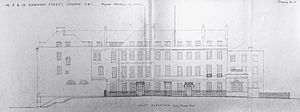Raymond Erith
Raymond Charles Erith RA FRIBA (7 August 1904 – 30 November 1973) was a leading classical architect in England during the period dominated by the modern movement after the Second World War.Since his death, exhibitions of his work have been held by the Royal Academy of Arts (1976),[1] Gainsborough's House, Sudbury (1979),[2] Niall Hobhouse (1986)[3] and Sir John Soane’s Museum (2004).This led him to John Soane, an important influence on his early designs but later he turned to earlier sources of inspiration and especially to Palladio and the robust practicality of his farmhouse villas.This experience and his country practice in East Anglia immediately after the war gave him a profound understanding of the local vernacular architecture, which was to have a subtle influence on his mature style.Major work includes 15,17 and 19, Aubrey Walk, London W8 (1951), The Pediment, Aynho, Northamptonshire, and its garden buildings (1956–73),[11] the Provost's Lodgings at the Queen's College, Oxford (1958),[12] and the Folly in Herefordshire (1961).

Second World Warmodern architectureDowning StreetRoyal AcademicianRoyal Fine Art CommissionRoyal Academy of ArtsSir John Soane’s MuseumtuberculosisArchitectural AssociationPercy Richard Morley HorderVerner Owen ReesLoughtonStockholmDedhamWindsor Great ParkKing George VINickolaus PevsnerJohn SoanePalladioEast Angliavernacular architecture12 Downing StreetIpswichcottagesLady Margaret HallOxfordJack Straw's CastleHampstead HeathGray's InnQueen's CollegeHerefordshireBentleyWaresideRingmerHampshireCooksbridgeQuinlan TerryRoyal AcademyDevonshireThe Twentieth Century Society